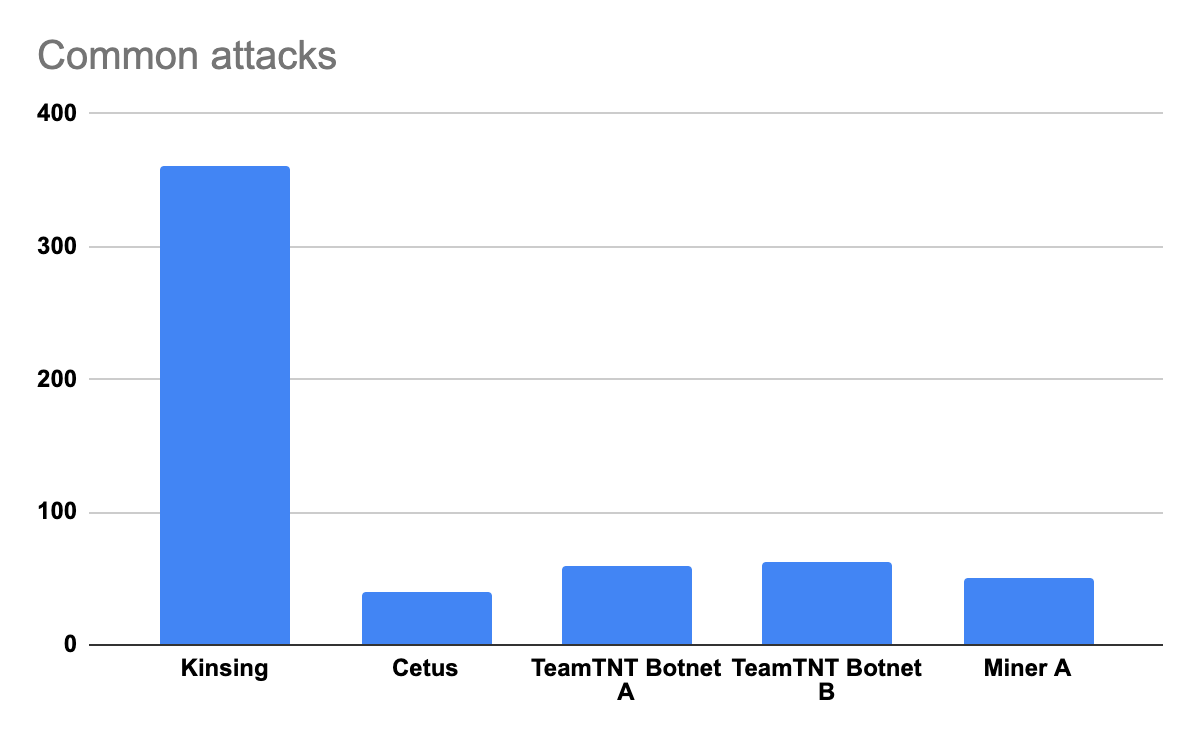Executive Summary
As part of our ongoing mission to assess and monitor cloud-related threats, we’ve deployed several types of honeypots and monitor them periodically. In this research, we will focus on a honeypot that mimics a misconfigured Docker daemon and explore the data obtained between March and April 2021, including 33 different kinds of attacks with a total of 850 attacks. More than 75% were cryptojacking attacks, and Kinsing was the most common malware with a total of 360 attacks. We will provide insights on how frequently the instance was attacked and detail the payloads. Some malicious images were involved in those activities, so we contacted the Docker security team to disclose them. The team responded quickly to remove the images from Docker Hub.
Misconfigured Docker daemons comprise a well-known security issue. Misconfigured daemons allow remote attackers to gain full control over a Docker instance and perform operations, such as deploying new containers and even escalating to the host. In the past, we found out there were 1,400 vulnerable Docker instances over the web and identified numerous cryptojacking malware that propagates using this security issue, such as Cetus, Pro-Ocean, Graboid and Black-T.
Palo Alto Networks customers running Prisma Cloud are protected from the malware mentioned above through Prisma Cloud Compute host compliance protection, which alerts on insufficient Docker daemon configuration, and via the Runtime Protection feature.
The Misconfiguration
Docker daemon exposes a restful API that allows users to interact with the daemon, which on default listens on a Unix socket. If remote access is required, the daemon can be configured to listen on a TCP socket. The issue is that there is no authentication or authorization mechanism by default when using a TCP socket. Anyone with access to the daemon can gain full privileges.
The Findings
Within a period of 50 days, we witnessed 33 different types of attacks out of a total of 850 attacks, which means the honeypot was attacked approximately every 90 minutes.
The attacks were frequent and made by many different threat actors. Attackers seem to acknowledge this and, in response, design their malware to identify rival counterparts and stop them, so that they will be the only malware in the system.
The majority of attacks were for cryptojacking purposes. Some of them only included a simple miner and some included sophisticated functionalities:
- Hiding miner activity.
- Stopping rival malware.
- Propagating to other machines.
- Gathering information.
- Establishing a command and control (C2) communication.
Other attacks were only for gathering information and sending it to a remote server or deploying tools, such as a distributed denial-of-service (DDoS) agent or a botnet agent.

Some attacks were more prevalent than others and, as seen in the chart below, Kinsing was the most common malware with a total of 360 attacks.

Another interesting point is that from the five most common attacks, TeamTNT is in charge of three – Cetus, TeamTNT Botnet A and TeamTNT Botnet B.

The botnets are two different new variants with an end goal of deploying a botnet and a malicious cryptominer. They use TeamTNT’s common techniques, such as stealing AWS credentials and deploying ziggy (IRC agent).

One of the variants also has capabilities that allow it to propagate through misconfigured Docker instances. It scans the internet for misconfigured Docker instances and, once it finds one, it sends the vulnerable IP to a C2 server and propagates by executing a malicious image on the vulnerable instance.

Unit 42 exposes TeamTNT’s malicious activities time after time. We monitor their activity and find new and complex malware they create every few months.
We called the last common attack “Miner A” since we could not determine its operators. It’s a simple XMRig miner that mines Monero.
Conclusion
Misconfigured Docker daemons are a well-known security issue that have been around for years, and attackers continue to take advantage. When comparing the results of our honeypot a year ago to our most recent exercise in March - April 2021, we can determine that malware that targets the cloud is getting more prevalent as attackers understand the potential of the cloud environment.
Palo Alto Networks customers running Prisma Cloud are protected from the malware mentioned above through Prisma Cloud Compute host compliance protection, which alerts on insufficient Docker daemon configuration, and via the Runtime Protection feature.

Indicators of Compromise
Find below the IOCs of the new malware we detected in this research.
Container Images
We contacted the Docker security team to disclose the images and they responded quickly and removed the images from Docker Hub.
| Image Name |
| mangletmpuser/dockgeddon |
| 0xe910d9fb6c/docker-network-bridge-ipv6 |
Table 1. Malicious images.
Domains/IPs
| 45[.]9[.]148[.]85 |
| 88[.]218[.]17[.]151 |
| 85[.]214[.]149[.]236 |
| 34[.]66[.]229[.]152 |
| 209[.]141[.]40[.]190 |
| 45[.]81[.]235[.]31 |
| 185[.]239[.]239[.]32 |
| 156[.]96[.]150[.]253 |
| oracle[.]zzhreceive[.]top |
Table 2. Malicious domains/IPs.
Files
| File Name | Sha256 | Description |
| NM | 1a0a3b52ff90fdd37d3036ec624e1dea2e78d6509c743ba2b5b815ece2e902d7 | Campaign A - Miner |
| NM.sh | 1b52560f4705b9cbeb95526a9736b1f1b48630270a7e1f308bf9b83e2b8d93ae | Campaign A - Deployment script |
| autom.sh | a0ca0dbaa0694fd7d837005d6221adf18d88bd0598cc7de807c2ccd14e6b579d | Campaign B - Deployment script |
| trace | 6f2825856a5ae87face1c68ccb7f56f726073b8639a0897de77da25c8ecbeb19 | Campaign B - Miner |
| log_rotate.bin | 3663d7640cdb63d2f0806fe6d382dafa7f453c98bda518492efddd29c3cc0cb9 | Campaign B - Deployment script |
| luk-cpu | d54157bb703b360bb911363d9bb483a2ee00ee619d566d033a8c316f06cf26cc | Campaign B - Miner |
| kinsing | 6e25ad03103a1a972b78c642bac09060fa79c460011dc5748cbb433cc459938b | Kinsing - Malware |
| d.sh | 981bea9cf9fbeda11088fcb9553ef5b27d09ef0fda3cbf3e7dd275b32c042976 | Kinsing - Deployment script |
| DDoS.pl | da3bc510087dbc49782dd9532de5c0a8213de077d943847969c9f8a83de5f181 | Campaign C - DDos script |
| init.sh | d1967ce49110fc6e9f25e3737463316911bcac616d7232f306407604b742f1a8 | TeamTNT Botnet A -Deployment script |
| dockerd | bd94b5629f71845314b3df4f1bfa9b17e0b0292d82d33c467d3bd6e52c5f3f4b | TeamTNT Botnet A - Miner |
| TNTfeatB0RG | 9504b74906cf2c4aba515de463f20c02107a00575658e4637ac838278440d1ae | TeamTNT Botnet A - Malware |
| stock.jp | 2c40b76408d59f906f60db97ea36503bfc59aed22a154f5d564d8449c300594f | TeamTNT Botnet B - Decompressed miner |
| mod.jpg | feb0a0f5ffba9d7b7d6878a8890a6d67d3f8ef6106e4e88719a63c3351e46a06 | TeamTNT Botnet B - Decompressed miner |
| dk.sh | 7b6f7c48256a8df2041e8726c3490ccb6987e1a76fee947e148ea68eee036889 | TeamTNT Botnet B - Deployment script |
| cf.jpg | eca42c42f0909cf4e6df6bf8de35ab93ef6a3dd10d0d5e556721ec1871a9990c | TeamTNT Botnet B - miner configuration |
| [crypto].pid | a674b55c3cf007418316f6ec2e774e757cb1c802ab47f8074ea0ffcf3dcb38a1 | TeamTNT Botnet B - miner configuration |
| [crypto] | 0d95f767c5f828695761e199b6e0b9fe62ace2902221540a33d331859648e761 | TeamTNT Botnet B - Miner |
| m | bffe45488cfe6fa309b380170eefcf731d9ff96aab919975664c537ad9cd1c9a | Campaign D - Miner |
| yy.sh | 305c87e43962f08206f3f923072ba3bb2bc0fa92e89f8b2a6319cbc21ccffe9d | Campaign E - Miner |
| x.sh | 2229b73467ef06091f1b86ef5592d65ac466bcf9bb953aec59920d2d23fdc5fa | Campaign E - Deployment script |
| d | 0c6231e4c68e127a89691cc8b396027fabdce11f2dd0ca9cf5617b7981e33c9f | Campaign F - Deployment script |
| dk32 | fe98548300025a46de1e06b94252af601a215b985dad31353596af3c1813efb0 | Campaign F - Malware |
| dk86 | 0e574fd30e806fe4298b3cbccb8d1089454f42f52892f87554325cb352646049 | Campaign F - Malware |
| xms | 08f29a12f2be9deb2e73f3b22c13445ed9cc00d4898323ccb91b1775fa4a13da | Campaign G -Miner |
Table 3. Malware hashes.












 Get updates from Unit 42
Get updates from Unit 42